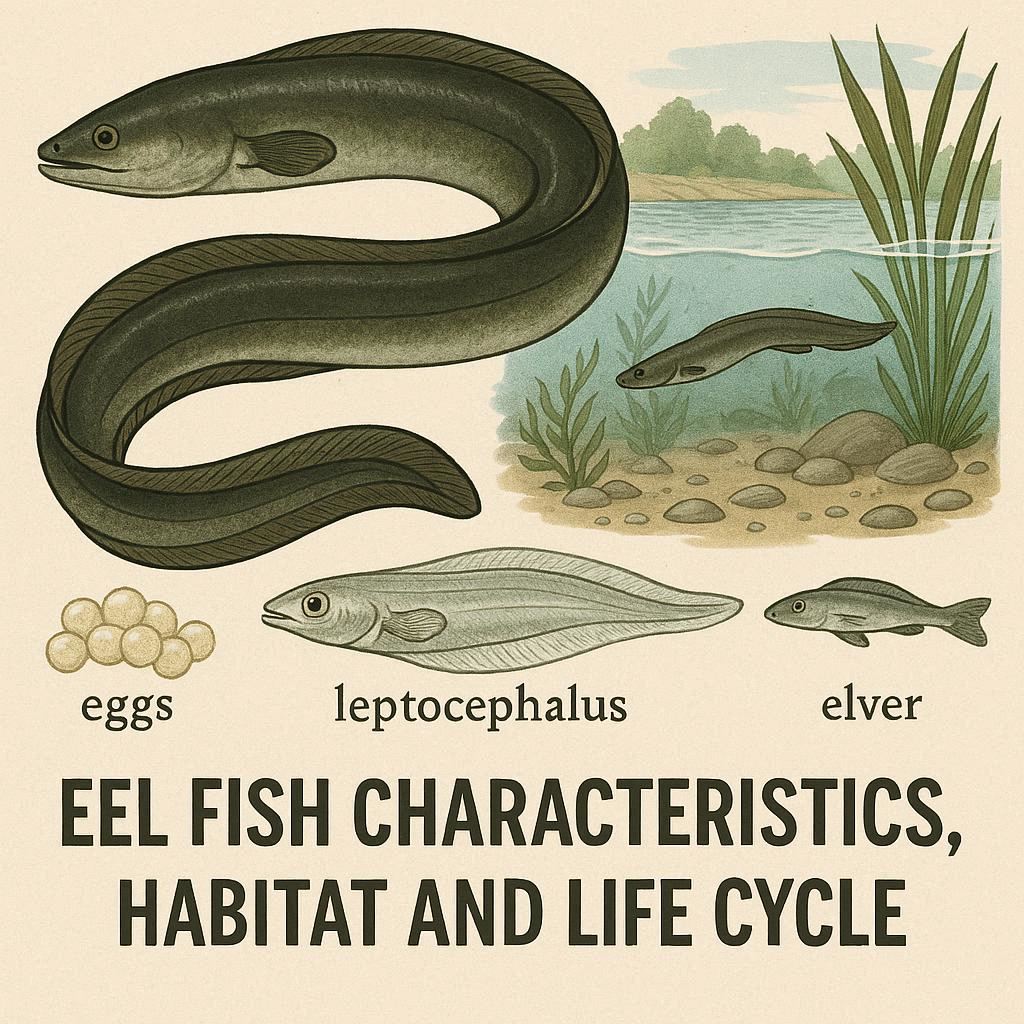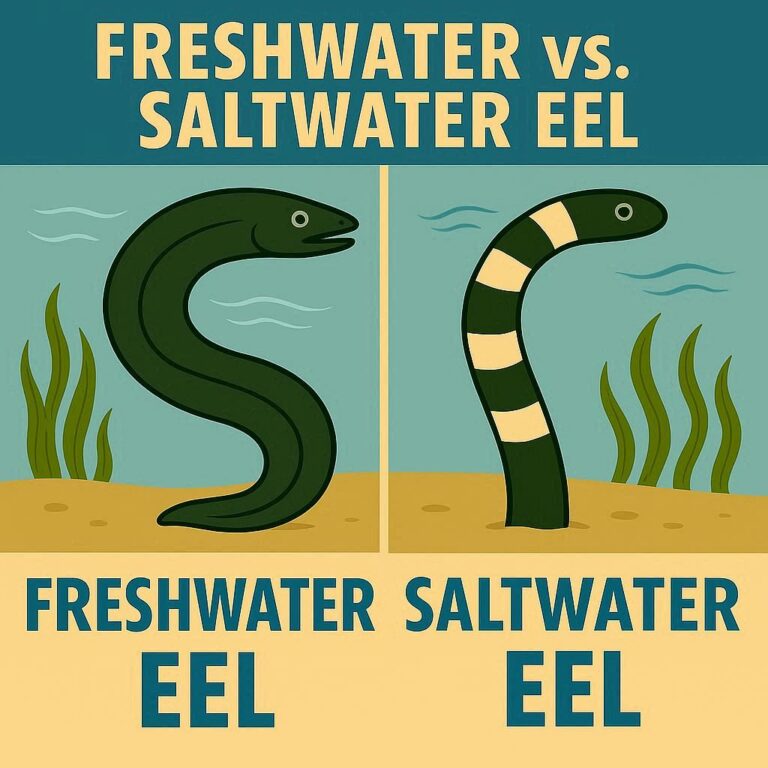
Eels are one of the most fascinating and mysterious fish groups in the aquatic world. With their snake-like bodies, secretive behavior, incredible long-distance migrations, and unusual reproduction methods, eels continue to captivate scientists and nature lovers. They live in oceans, rivers, lakes, and murky estuaries, making them one of the most adaptable aquatic species.
This guide explains eel characteristics, classic habitats, and the amazing life cycle of these slippery, serpentine fish.
Characteristics of Eel Fish
1. Body Shape and Appearance
Eels have long, slender, cylindrical bodies that resemble snakes. Key features include:
No pelvic fins, and many species also lack pectoral fins
Continuous dorsal, caudal, and anal fins, forming a single ribbon-like fin
Smooth or mucus-covered skin that reduces resistance in water
Tough, flexible skeleton that helps them twist and slip into crevices
Their shape helps them glide through narrow spaces, mud, coral reefs, and underwater vegetation with ease.
2. Skin and Scales
Most eels do not have obvious scales, but many have:
Embedded microscopic scales under the skin
A thick layer of mucus for protection and hydration
The mucus allows eels to:
Reduce friction
Avoid parasites
Survive short periods on land during damp nights (some species)
3. Size and Color
Eel sizes vary greatly:
Small species: 5–10 cm
Common freshwater eels: 30–100 cm
Giant species like the moray eel: up to 3 meters
Coloration depends on age, species, and habitat. They can be:
Brown
Greenish
Black
Yellow
Speckled
Brightly patterned (especially moray eels)
4. Behavior
Eels are mostly:
Nocturnal, active at night
Solitary, often hiding during the day
Skilled burrowers in mud, caves, and crevices
Freshwater eels are known for their incredible endurance, often crawling over wet land or climbing dams during migration.
5. Diet
Most eels are carnivores. Their diet includes:
Worms
Crustaceans
Small fish
Insects
Mollusks
Moray eels often ambush prey from rocky holes, using their unique second set of jaws (pharyngeal jaws) to pull food into their throat.
Habitat of Eel Fish
Eels are found across the world, from shallow ponds to deep oceans.
1. Freshwater Habitats
These include:
Rivers
Lakes
Streams
Marshes
Reservoirs
Many freshwater eels (like the American and European eel) spend most of their lives inland but migrate to the ocean to spawn.
2. Marine (Saltwater) Habitats
Marine eels such as moray eels and conger eels prefer:
Coral reefs
Rocky crevices
Underwater caves
Deep sea environments
These species complete their entire life cycle in saltwater.
3. Estuaries and Brackish Water
Many eel species live in:
Mangrove swamps
Coastal marshlands
These environments offer:
Abundant food
Shelter from predators
A mix of fresh and saltwater critical for certain stages of development
4. Deep Sea
Some eels inhabit depths over 1,000 meters, where:
Light is minimal
Pressure is extreme
Food is scarce
Deep-sea eels have adapted with large mouths, reduced eyesight, and bioluminescent features.
Life Cycle of Eel Fish
Eels have one of the most complex and mysterious life cycles in all aquatic species. Here is a simplified breakdown:
1. Spawning (Breeding) Stage
Most freshwater eels are catadromous, meaning:
They grow in rivers
But spawn in the ocean
The best-known example is the European and American eel, both of which migrate thousands of kilometers to the Sargasso Sea (near the Atlantic Ocean) to breed.
Scientists have never observed eel spawning directly. Adult eels likely die after spawning.
2. Egg Stage
After spawning:
Eggs float in warm ocean currents
They hatch into transparent larvae
Eggs are extremely tiny and drift passively with ocean currents.
3. Leptocephalus Larvae Stage
Eel larvae are called leptocephali. They look like:
Thin, transparent strips
Leaf-shaped bodies
Nearly invisible
They drift for months (sometimes years), slowly moving toward coastal waters.
4. Glass Eel Stage
When leptocephali reach shallow water, they transform into glass eels, which are:
Small
Transparent
Shaped like miniature eels
This is the stage when eels enter:
River mouths
Estuaries
Bays
Thousands may arrive together in massive migrations.
5. Elver Stage
Glass eels darken and become elvers, which:
Gain pigmentation
Start eating actively
Swim upstream into rivers
Some elvers travel hundreds of kilometers inland, even climbing rocks and dams.
6. Yellow Eel Stage (Growth Stage)
This is the longest period in an eel’s life:
Eels develop yellowish coloration
Live in freshwater rivers or coastal waters
Grow for 5–20+ years
Feed at night
They are called “yellow eels” due to their brown-yellow appearance.
7. Silver Eel Stage (Adult Migratory Stage)
When mature, eels transform again:
Skin becomes silver
Eyes enlarge (for deep-sea vision)
Body becomes streamlined for migration
Silver eels migrate back to the ocean to spawn, repeating the cycle.
Unique Adaptations of Eel Fish
1. Ability to Breathe Through Skin
In damp conditions, many eels can absorb oxygen through their skin, allowing limited survival on land.
2. Climbing Ability
Young eels can climb rocks, vegetation, and even dam walls during migration.
3. Electric Eels (Not True Eels)
Electric eels are often mistaken for true eels, but they are actually knifefish. However, they show how eel-like bodies evolve repeatedly in nature.
Importance of Eels in Ecosystems
Eels play key roles such as:
Controlling insect and fish populations
Being prey for birds, mammals, and larger fish
Recycling nutrients in rivers and wetlands
Unfortunately, many eel species—especially the European eel—are now endangered due to overfishing and habitat loss.
Human Use of Eel Fish
Humans use eels for:
Food (unagi, smoked eel, stew)
Aquaculture
Traditional medicine
However, conservation efforts push for sustainable harvesting and habitat restoration.
Threats to Eel Populations
Major threats include:
Overfishing (especially juvenile glass eels)
Dams blocking migration routes
Pollution
Climate change altering currents
Habitat destruction
Conservationists now use eel ladders, protected areas, and captive breeding attempts to save populations.
Conclusion
Eels are incredibly complex, mysterious, and adaptable fish with one of the most remarkable life cycles on Earth. From drifting transparent larvae in the open ocean to migrating thousands of kilometers back to spawning grounds, eels demonstrate extraordinary survival strategies. Their habitats span freshwater, saltwater, brackish estuaries, and deep-sea environments.
Understanding eel characteristics and their life cycle is crucial for protecting these extraordinary creatures, many of which now face serious environmental threats.






